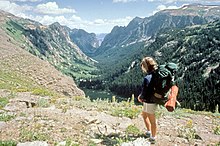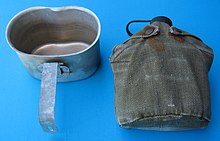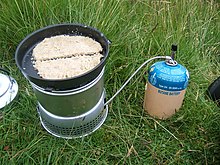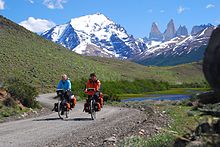Backpacking (hiking)


Backpacking is the outdoor recreation of carrying gear on one's back while
Backpacking as a method of travel is a different activity, which mainly uses public transport during a journey that can last months.
Definition
Backpacking is an outdoor recreation where gear is carried in a backpack. This can include food, water, bedding, shelter, clothing, stove, and cooking kit. Given that backpackers must carry their gear, the total weight of their bag and its contents is a primary concern of backpackers. Backpacking trips range from one night to weeks or months, sometimes aided by planned resupply points, drops, or caches.
Research
Carrying loads appears to have differentiated humans from other animals.[4]
Fitness benefits
A weighted carry from backpacking taxes muscles.[4] A weighted load stresses the shoulders, delts, back, abs, obliques, hips, quads, hamstrings and the knees.[4] Research highlights a weighted carry for exercise helps avoid injuries.[4]
A differential exists between a man running in comparison to a man walking whilst carrying a backpack.[4] A 175-pound man running, without a backpack, loads his knees with 1,400 pounds of stress per stride.[4] Whilst a 175-pound walking man, carrying a 30-pound pack, loads his knees with 555 pounds of stress per step.[4]
Research shows humans can carry weight under 50-pound in a safe manner.[4] Research also shows a weighted carry is as beneficial for the cardiovascular system as a light run.[4]
Accommodations
Backpacking camps are usually more spartan than campsites where gear is transported by car or boat. In areas with heavy backpacker traffic, a hike-in
In some regions, varying forms of accommodation exist, from simple log lean-to's to staffed facilities offering escalating degrees of service. Beds, meals, and even drinks may be had at
In the more remote parts of Great Britain, especially Scotland,
Equipment
Backpacking gear depends on the terrain and climate, and on a hiker's plans for shelter (refuges, huts, gites, camping, etc.). It may include:
- A backpack of appropriate size. Backpacks can include frameless, external frame, internal frame, and bodypack styles.
- Clothing and footwear appropriate for the conditions.
- Food and a means to prepare it (stove, utensils, pot, etc.).
- Sleep system such as a sleeping bag and a pad.
- Survival gear.
- A shelter such as a tent, tarp or bivouac sack.
- Water containers and purifiers.
Water

Proper hydration is critical to successful backpacking. Depending on conditions - which include weather, terrain, load, and the hiker's age and fitness - a backpacker may drink 2 to 8 litres (1/2 to 2 gallons), or more, per day. At 1 kilogram (2.2 lb) per 1 litre (1.1 US qt)[6] water is exceptionally heavy. It is impossible to carry more than a few days' supply. Therefore, hikers often drink natural water supplies, sometimes after filtering or purifying.
Some hikers will treat water before drinking to protect against
. The chief treatment methods include:- Boiling
- Treatment with chemicals such as chlorine or iodine
- Filtering (often used with chemical treatments)
- Treatment with ultraviolet light
Water may be stored in bottles or collapsible plastic bladders.
Food


Backpacking is energy intensive. It is essential to bring enough food to maintain both energy and health. The weight of food is an important issue to consider. Consequently, items with high food energy, long shelf life, and low mass and volume deliver the most utility. Taste and satisfaction are issues that are of varying importance to individual hikers, as they consider whether it is worth the effort (and trade-off against other gear) to carry fresh, heavy, or luxury food items. The shorter the trip and easier the conditions the more feasible such treats become.
In many cases, heat, fuel and utensils are used. Small liquid or gas-fueled campstoves and lightweight cooking pots are common. Campfires are sometimes prohibited.
Some backpackers consume dried foods, including many common household foods such as cereal, oatmeal, powdered milk, cheese, crackers, sausage, salami, dried fruit, peanut butter, pasta and rice. Popular snacks include trail mix, easily prepared at home; nuts, energy bars, chocolate, and other energy-dense foods. Coffee, tea, and cocoa are common beverages. Package food in plastic bags while avoiding heavier jars and cans. Dehydrators are popular for drying fruit, jerky, and pre-cooked meals.
Many hikers use
Specialized cookbooks are available on trailside food and the challenges inherent in making it. Some focus on planning meals and preparing ingredients for short trips; others on the challenges of organizing and preparing meals revolving around the bulk rationing prevalent in extended trail hikes, particularly those with pre-planned food drops.
Ultralight-hiking
Some people seek out lighter equipment for long-distance hikes, as it is easier to carry, reduces physical strain, and allows for ease of long distance travel. Ultralight gear has become increasingly more commonly used in past years as it reduces the strain on the hiker. Specialist ultralight gear is widely available, but can be expensive. Materials can include carbon fiber, lightweight alloys, specialty plastics, and impregnated fabrics.
Skills and safety

- Survival skills can provide peace of mind and may make the difference between life and death when the weather, terrain, or environment turns unexpectedly for the worse.
- Navigation and orienteering are useful to find the trailhead, then find and follow a route to a desired sequence of destinations, and then an exit. In case of disorientation, orienteering skills are important to determine the current location and formulate a route to somewhere more desirable. At their most basic, navigation skills allow one to choose the correct sequence of trails to follow. In situations where a trail or clear line-of-sight to the desired destination is not present, navigation and orienteering allow the backpacker to understand the terrain and wilderness around them and, using their tools and practices, select the appropriate direction to hike. Weather (rain, fog, snow), terrain (hilly, rock faces, dense forest), and hiker experience can all impact and increase the challenges to navigation in the wilderness.
- hypoxia, as these are rarely encountered in daily life.
- golden rule: To have beautiful and pristine places to enjoy, help make them. At a minimum, do not make them worse.
- Distress signaling is a skill of last resort.
Related activities
Winter backpacking
Winter backpacking requires a higher level of skill and generally more specialized gear than in other seasons.
A winter bivouac can also be made in a snow cave. It has thermal properties similar to an igloo and is effective both at providing protection from wind and low temperatures. A properly made snow cave can be 0 °C (32 °F) or warmer inside, even when outside temperatures are −40 °C (−40 °F).[7][8] It is constructed by excavating snow so that its entrance tunnel is below the main space in order to retain warm air. Construction is simplified by building on a steep slope and digging slightly upwards and horizontally into the snow. The roof is domed to prevent dripping on the occupants. Adequate snow depth, free of rocks and ice, is needed — generally 4 to 5 ft (1.2 to 1.5 m) is sufficient. A quinzhee is similar, but constructed by tunneling into mounded snow rather than by digging into a natural snow formation.
Fastpacking
Other

- Canoe and kayak camping
- Bicycle touring and its lightweight variant bikepacking
- saddlebags
- Backpacking (travel), where public transport is used to visit cultural attractions, rather than natural ones, though it may also include wilderness side trips.
- Adventure travel, tourism in a highly unpredictable or hazardous region or environment.
- Thru-hiking, traversing a long-distance trail in a single, continuous journey.
- Ultralight backpacking, which minimizes both weight and amount of gear carried, typically employed in highly aerobic back-country pursuits.
- Wilderness survival
See also
- Backpacking with animals
- Bivouac shelter
- Camping
- Hiking equipment
- Long distance trail
- Mountaineering
- Nordic walking
- Rambling
- Ten essentials and Survival kit
- Trekking pole
References
- ^ "Travel or hike carrying one's belongings in a backpack: [e.g.] a week's backpacking in the Pyrenees, [or] he has backpacked around the world" (New Oxford American Dictionary).
- ^ H. W. Orsman, The Dictionary of New Zealand English. Auckland: Oxford University Press, 1999.
- ^ a b "Trail Development". Archived from the original on 2014-04-01. Retrieved 2013-12-13.
- ^ a b c d e f g h i Easter, Michael (11 May 2021). "How Rucking Can Benefit Your Running Performance". runnersworld.com.
- ISBN 9788183860376.
- ^ "Comparisons and Conversions". pp. 2nd paragraph. Retrieved 2009-05-08.
- ^ "Quinzee (aka - Snow Cave)". AlphaRubicon.com. Retrieved 2007-01-30.
- ^ Gerke, Randy. "When Storms Rage (or how to build a snow cave)". Enviro-Tech International. Retrieved 2007-01-30.
- ^ Siber, Kate (2009-08-06). "Fastpacking: What, and Why?". Runner's World. Retrieved 2023-01-02.
- ^ Clint Cherepa, "Hike Fast, Sleep Hard: Are You Ready to Try Fastpacking?" Archived 2021-01-23 at the Wayback Machine Outdoors.org, August 27, 2018.
- ^ Ad Crable, "Running wild", Lancaster New Era, June 18, 1993.
- ^ Kinsella, Patrick (May 5, 2017). "Run, don't walk: mastering the art of fastpacking". Lonely Planet. Retrieved 2023-01-02.
External links
- American Hiking Society Preserves and protects hiking trails and the hiking experience
- Leave No Trace - The Leave No Trace Center for Outdoor Ethics is an educational, nonprofit organization dedicated to the responsible enjoyment and active stewardship of the outdoors by all people, worldwide.
